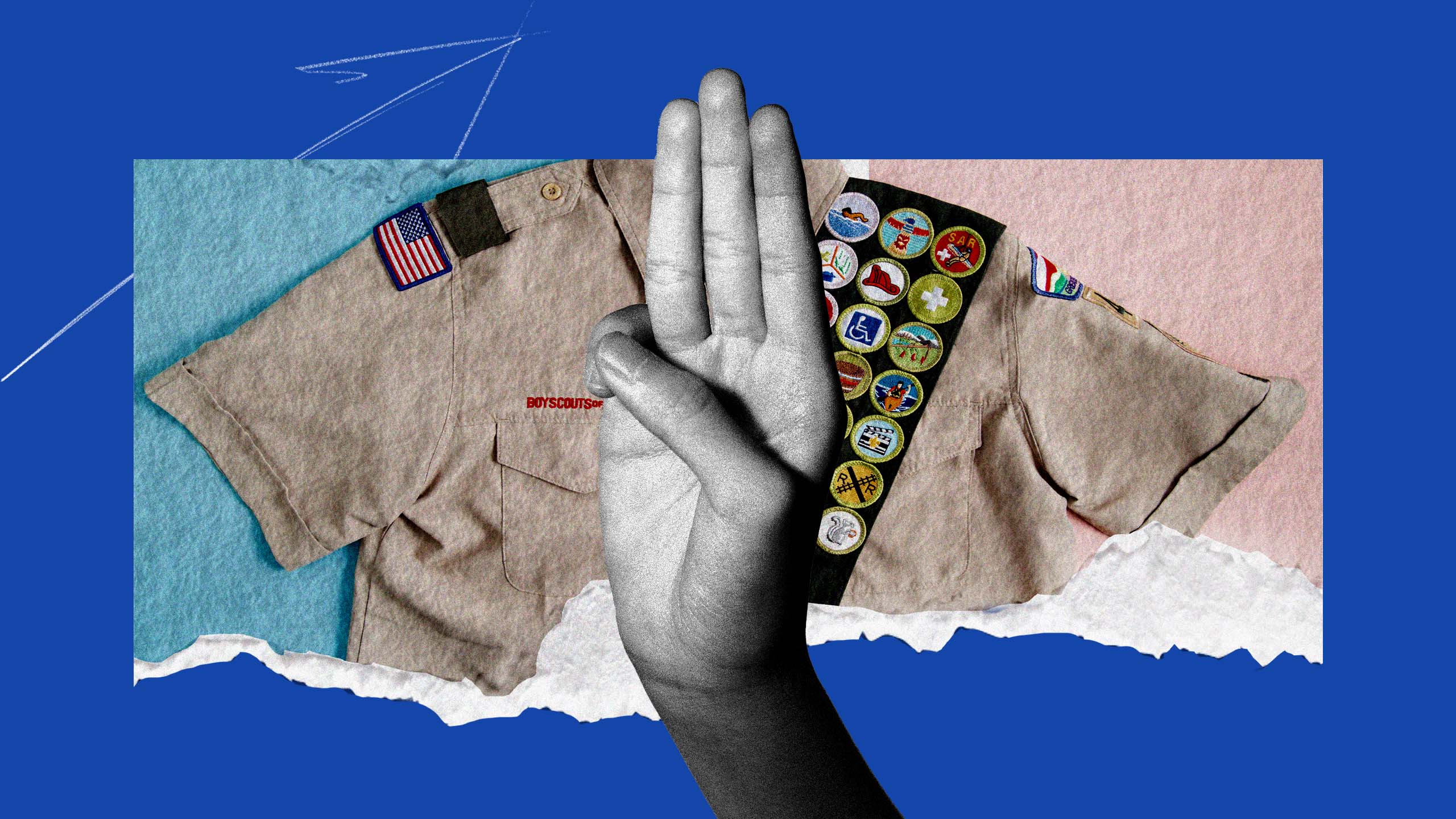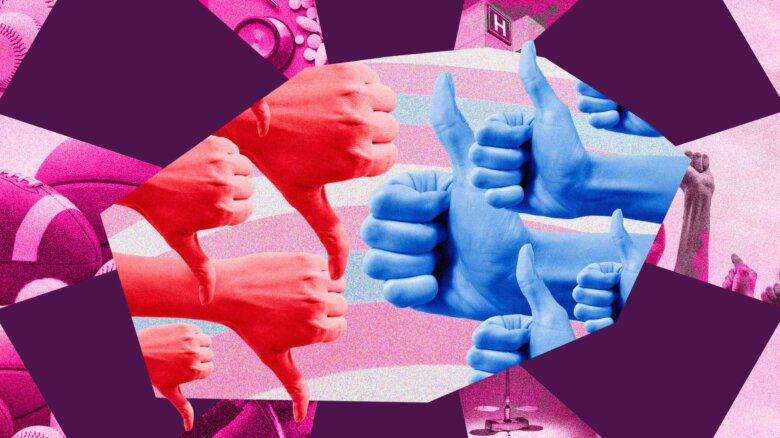In what could easily become a record-breaking year for anti-LGBTQ2S+ legislation, trans youth are at the centre of the latest American culture war. Their ability to play sports, receive healthcare or even talk about their gender identity is under attack in Texas, Georgia, Florida and beyond.
But there’s one surprising place where almost none of that is happening, at least on paper: the Boy Scouts of America (BSA). Since the organization moved to allow trans boys in 2017 (and shortly after opened its signature program to girls and women), trans participation has not been an all-encompassing debate in the way that gay membership roiled the BSA for decades. There have been no high-profile issues with the policy, and no organized efforts to roll it back.
Whether by a stroke of strategic genius, or by simple exhaustion after fighting the 40-year gay-membership battle, the BSA has managed to get ahead of the issue of trans youth to some degree. But while trans kids are no longer barred from the organization, it’s an open question whether the BSA’s policies rise to the level of “inclusion.” Membership often plays out on a local troop level, where inclusion is not enforced, and big questions about trans participation remain unanswered by national guidelines.
A history of gender lines
The Boy Scouts, as most people think of it, has long been a program for cisgender boys. But for decades, people of other genders have been allowed to participate. The BSA has allowed girls into the ranks since the 1970s, through two of its lesser-known programs: Venturing and Sea Scouts.
In 2017, the gender restrictions loosened once again, as the BSA decided to allow trans boys into the ranks of its signature, Eagle-Scout-producing program: the Boy Scouts. The change took place after less than three months of light controversy. The decision was spurred by Joe Maldonado (no, not that one). He was an eight-year-old trans boy from New Jersey who was expelled from Cub Scouts due to his gender identity. At the time, the BSA’s policy was to rely on the gender listed on each child’s birth certificate, a method that also forms the basis for many anti-trans sports bills.
Maldonado was kicked out of his unit in November 2016. His mother, Kristie, wasted no time trying to reverse the decision. With the help of Garden State Equality, a statewide LGBTQ+ rights group, the Maldonados garnered local and national news attention, effectively putting the BSA on notice.
But before Kristie Maldonado could even file a discrimination complaint against the local Boy Scout council, the national BSA office changed its policy to let Joe rejoin the Cub Scouts. There was no decades-long policy debate. No court battles. Hardly even a national advocacy campaign. About 90 days after Joe was kicked out, he was back in, thanks to a fundamental change to the BSA’s membership requirements.
In a two-minute video announcing the policy change, then chief scout executive Michael Surbaugh sounded entirely matter of fact.
“We and others have recently been challenged by a very complex topic on the issue of gender identity,” he began. He went on to explain that the BSA had always deferred to birth certificates to determine membership eligibility, much like schools and sports teams had done.
“After weeks of significant conversations at all levels of our organization, we realize that referring to birth certificates as the reference point is no longer sufficient,” Surbaugh continued.
The new policy of the BSA, Surbaugh explained, would be to defer to the gender identity listed on the membership application. (Surbaugh, who is now retired, could not be reached for comment.)
While this shift certainly made national news headlines and irritated the BSA’s more conservative faction, it didn’t rock the organization in the way that other membership changes did: there was no organized, public backlash. That’s likely because the change was soon overshadowed by a much bigger, more controversial, announcement regarding gender late that year: girls would be allowed to pursue the rank of Eagle Scout, with the main program rebranded from Boy Scouts to Scouts BSA.
How it came together
By the time Joe Maldonado was kicked out of Cub Scouts, his family was already used to fighting for his rights. They had previously worked with Garden State Equality to make sure Joe would have his gender identity affirmed as he attended elementary school. So, when the group heard about Maldonado’s expulsion from Scouts, they were ready to fight again.
“We took the stance that trans boys are boys, and that he should have the right to be in the local troop,” says Christian Fuscarino, executive director of Garden State Equality. “Any time that a trans child is excluded from having the experience that other children have, we get involved to ensure that there’s equality in the policy.”
Fuscarino’s default strategy was to work with, rather than against, an organization. But his initial outreach to BSA officials went unanswered, so Garden State Equality decided to launch a national petition on Change.org.
“We thought that public pressure would be the best option at that point,” Fuscarino said.
The petition quickly gained traction, receiving signatures and news coverage from across the U.S. Not long after the petition was shared with BSA executives, the policy changed in Maldonado’s favour.
“We were surprised and pleased with how quickly they moved,” Fuscarino said. “I think that they saw the importance of ensuring that trans boys have the same opportunties as cisgender boys. And I would like to think that they had good intentions in making sure transgender kids were actively involved.”
Fuscarino said it also helped that many of the BSA’s board members were corporate leaders whose own companies had queer- and trans-friendly policies. “Excluding transgender individuals from participating in programs like the Cub Scouts is not a value that I think companies would get behind,” he explained.
The decision to centre Maldonado’s lived experience in their advocacy, while working to protect him from the public vitriol that might come his way, also made a big difference, Fuscarino said.
“Once they heard about Joe, who did an incredible job as a young advocate who was only eight years old … [it] opened a lot of hearts and minds within the organization because you are hearing this directly from a young individual who’s so clearly articulating their lived experience,” Fuscarino said.
Where BSA stands today
Although they are no longer barred from participating, trans and especially non-binary youth in the BSA do still face challenges. Chief among them is that membership decisions are left up to local Scouting units—all of which are chartered by churches or civic organizations that hold significant power in the BSA—and inclusion is not actively enforced by the national office.
Derrick*, a 14-year-old trans scout from Texas, had to cycle through multiple troops before finding one that would accept him. (Derrick asked to be referred to by a pseudonym, given the dire state of trans rights in his home state.)
He started his scouting journey in the Girl Scouts of the USA, an organization that is entirely separate from BSA, and which also allows trans participants to join. There, he discovered a love for hiking and camping. Around the time he started identifying as non-binary, he sought out Scouts BSA, the core Boy Scouts of America program that now operates with a binary system of “girl troops” and “boy troops.” The girl troop Derrick joined felt like a good fit for a little while, until he found out the troop leader’s wife was active on the pro-Trump, conspiracy-laden social platform Parler.
By this point, Derrick wanted to join a boy troop, anyway, because he had started identifying as transmasculine, highlighting a fundamental challenge to the binary troop system.
“For me personally, I was able to just ‘pick boy,’ but I think for other people that would be harder to do,” Derrick told me. He was indeed allowed to join a boy troop, but it took a few tries before Derrick and his mother found a suitable unit; one sponsored by his family’s church. He was allowed to join only after a string of meetings with church and troop leadership to ensure his safety and acceptance. But in the year since he settled in, he’s advanced multiple ranks and earned more than 20 merit badges.
Derrick’s story is not unique, and similar challenges continue to pop up around the country. In a Facebook group for the LGBTQ+ community in Scouting, adult leaders often ask for advice on accommodating and supporting trans youth. They pose logistical questions and often receive threads of encouraging comments, even if easy answers aren’t always available.
It underlines a simple fact: although trans youth are not barred, the BSA has done little to create guidelines for their inclusion, or to train its adult leaders on the matter. The organization’s reticence also speaks volumes. As attacks on trans rights spread across the U.S., the BSA has not exactly been bragging about its trans-inclusive policy; its leaders would prefer, it seems, to stay out of the fray entirely. (The BSA’s executive DEI director, Lisa Schuchart, declined to be interviewed for this article.)
If you ask Derrick, there’s one more change the BSA needs to make in regards to gender: get rid of the binary troop system in favour of all-gender units.
“It’s really ridiculous to limit people,” he says. “It seems pointless to have them separated.”


 Why you can trust Xtra
Why you can trust Xtra


